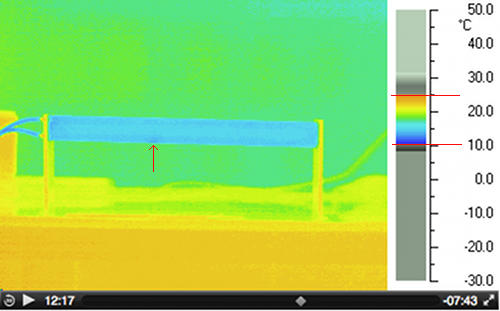I borrowed the thermal camera from David Lynn, and made a holder for the staves. I was looking to identify the leak location since the cold liquid would perhaps show up in the thermal image.
- 0:00 - The stave is at room temperature (~21°C), same as the table, and higher than the wall in the background. No liquid is circulating.
- 1:00 - The cooling liquid (chiller setpoint 40°F) has started flowing, and you can see it entering the stave bottom left.
- 1:20 - Much of the stave is now the same temperature as the wall,
and is partially invisible.
- 1:40 - By this time, the bottom tube is colder than the wall.
- 3:00 - The tube is cold, but no sign of leak is visible.
- 5:00 - In this replay, the temperature color scale is set to 10-25°C, but the chiller is set to 40°F = 4.5°C. The gray indicates T<10.
- 7:30 - The cooling has been turned off, and a fan (on the left, mostly offscreen) is turned off to warm the stave. It also evaporates any Novec that has leaked out, creating a cold spot where the leak is.
- 12:17 - In this frame you can see the cold spot along the bottom, about 40% from the left.
- 18:30 - The spot is found and marked.

- I observed what looked like instant wetting along a 1-2cm line along the center line of the wall.
- Suddenly, a jet of coolant squirted from the tube, but stopped after a few seconds.
- It took a lot of fiddling to make the spray happen again. We raised and lowered pressure, and temperature, and we saw the spray twice more, and managed to photograph it once. In between, the pressure did not drop at all, though the surface was sometimes wet.